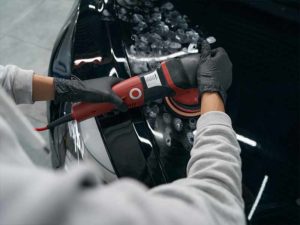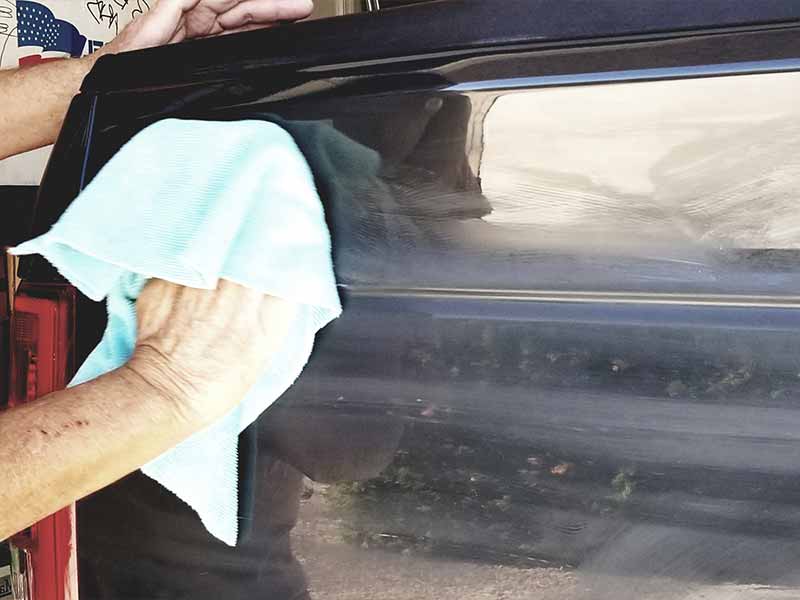Table of Contents
- How to remove oxidation from car paint
- What Is Car Paint Oxidation?
- Levels of Car Paint Oxidation
- What Product Removes Oxidation from Car Paint?
- How to Remove Light Oxidation Spots from Car Paint with Polishing Compound
- How to Remove Heavy Oxidation from Car Paint with Rubbing Compound
- Frequently Asked Questions
- Conclusion
Wouldn’t it be great if you could just leave your car outside in the elements and not have to worry about any kind of damage? That’s a dream world, but we live in reality where oxygen is present in the air and can cause your paint to dry out when mixed with excessive heat.
How to remove oxidation from car paint
- Move your vehicle into a well-shaded area
- Thoroughly wash and dry your vehicle with a microfiber cloth
- Use a polishing compound to remove the light oxidation damage
- Use a dry microfiber towel to wipe it off
- Apply a wax coating or paint sealant
While prevention is the best medicine, if the damage is done, you need to remove oxidation from your car’s paint. In doing so, you will restore its glossy shine, protect the paint, and increase the car’s resale value.
What Is Car Paint Oxidation?
Car paint oxidation occurs when the chemicals in the auto paint begin to breakdown from being exposed to the elements for an extended period of time. One of the most harmful elements for your auto paint is ultraviolet rays from the sun. These UV rays result in heating building up beneath the clear coat, which then mixes with oxygen, and results in the breakdown of the paint oils. Of course, other elements like road grime, dirt, and weather can also cause oxidation of your car’s paint.
You will know that your vehicle’s paint has started to oxide when you notice the paint starting to dull in color, the color starting to completely fade away, and a patchy or chalky surface over the entire car.

Levels of Car Paint Oxidation
There are four main levels of car paint oxidation, which will start to occur if your vehicle is left out in the elements without the proper protection.
Light
The first level of car oxidation, which is referred to as light oxidation, will start to occur after your vehicle has been constantly exposed to the elements for a period of time. Don’t expect to notice the signs of oxidation after a month or two, but this doesn’t mean it isn’t there and eating away at the top layer of your car’s finish. Usually, this level of oxidation can be treated with regular auto detailing and polishing. You can protect your paintwork by adding a wax coating to the vehicle’s paint surface.
Moderate
The second level of car oxidation, which is referred to as moderate oxidation, occurs over time. You will likely notice the paint beginning to fade, and before long, the paint loses its original color. Luckily, this level of oxidation can be repaired with a cutting polish, which will restore shine.
Heavy
The third and final level of car oxidation, which is referred to as heavy oxidation, is the hardest to repair. This type of oxidation can occur to your paintwork if you leave your vehicle unprotected for more than a year. It will cause your paintwork to appear dull and chalky. This level of oxidation generally requires a complete repaint to be repaired.
Clear Coat Failure
Ultimately, clear coat failure is when the oxidation is not stopped in one of the three stages mentioned above and leads to the destruction of the clear coat finish. This is the final stage of oxidation. If you haven’t already, you will notice patches appearing on your vehicle where the paint itself has started to dissolve from its extended exposure to the elements. At this point, your only option for repair is to have the oxidized surfaces repainted.
What Product Removes Oxidation from Car Paint?
As long the car paint oxidation has not gotten to the stage of where the clear coat has been destroyed completely, you can repair car paint oxidation. It is better to attempt repair during the light and moderate stages of oxidation as opposed to heavy oxidation. The more severe the oxidation, the more difficult and time-consuming the repair process is.
However, the two main products that can remove oxidation from car paint are rubbing compounds and polishing compounds. Both of these act similar to sandpaper when applied to your car’s surface, and because of this, they remove the imperfections in the paint.

How to Remove Light Oxidation Spots from Car Paint with Polishing Compound
When removing light oxidation spots from car paint with a polishing compound, your first step is to move your vehicle into a well-shaded area. Ideally, the temperature should be around 70 to 75 degrees.
This is important, as it will help keep your vehicle from developing water sports and accumulating dust. Next, thoroughly wash and dry your vehicle with a microfiber cloth before starting the actual polishing process.
Next, you will use a polishing compound to remove the light oxidation damage. You can do this by hand or with a buffer if you have the experience. Doing it by hand can minimize the chances of causing more damage to your car, although it will take longer to complete the task.
The polishing compound should be applied in a thin layer over a small area, gently rubbing it into the affected panels, and then immediately removed. Make sure you are using a clean, wet microfiber cloth, as this will help to prevent swirl marks from forming on the paint’s surface. Use a dry microfiber towel to wipe it off. Switch to a new, clean towel occasionally to avoid the formation of swirl marks.
Once the compound has been worked in and all of the oxidation has been removed from the surface of the paint, you need to apply a wax coating and/or paint sealant to the car. The wax serves as a protective layer for your auto paint. Try to wax at least once per month to reinforce that layer of protection and help prevent future oxidation.

How to Remove Heavy Oxidation from Car Paint with Rubbing Compound
In order to remove heavy oxidation from car paint, you will follow the same steps above as you did with removing light oxidation spots except you will switch out the polishing compound with a rubbing compound. It is a bit more abrasive than a polishing compound, which is why it is used for heavy oxidation.
Frequently Asked Questions
Why Is the Paint on My Car Oxidizing?
The paint on your car is oxidizing because it has been left exposed to the elements for a long duration of time.
When exposed to the sun, the ultraviolet rays will heat up the paint. The combination of the heat and the oxygen in the atmosphere creates a chemical reaction that causes your car’s paint to oxidize. This leads to the oil in the paint drying out and fading.
What Does Oxidized Paint Look Like?
The appearance of oxidized paint can vary based on its severity. However, the most common sign of oxidized paint is a chalky residue, which gives your paint a dusty or milky appearance.
The color of the paint may also start to fade, especially as the oxidation worsens and the paint pigment starts to break down. Eventually, the paint will start to deteriorate in patches, especially on the hood, roof, or trunk lid.
Will a Clay Bar Remove Oxidation?
A clay bar alone will not remove oxidation. However, it can be used to clean the surface of the paintwork and remove any contaminants that may have been left behind after washing.
This creates a nice clean surface that is ready for the compound to be applied to it. Using a clay bar may remove some of the oxidation in the process, but you will still need to follow up with a polishing or rubbing compound.
How to Prevent Oxidation on Car Paint
There are numerous steps you can take to prevent oxidation of car paint, and prevention is always better than treatment and repair. To begin, you can wax your vehicle at least once per month.
You should store your vehicle in a garage or underneath a covered carport. If this is not possible, you should seriously consider investing in a custom car cover. This will help to keep dust, debris, and other environmental elements off the paintwork of your car and protect it from unnecessary damage.
Further, you should wash your vehicle yourself with soapy water and a soft cloth rather than taking it to a commercial car wash.
Conclusion
Car paint oxidation is almost inevitable, making it virtually impossible to eliminate oxidation completely.
However, it is possible to minimize the risk of it occurring by waxing your car regularly, avoiding the commercial car wash, covering your vehicle with a custom-fitted car cover, and storing your vehicle out of the direct sunlight.









